We know everyone is reeling from the global pandemic, which is why we wanted to share a happier medical story.
One of our wonderful physician assistants, Donna Robbins, traveled to Peru in early January on a special medical mission (this mission was unrelated to COVID-19).
Donna agreed to sit down with us for a Q&A session about her experience.
Tell us the background about how this trip came about
DONNA: I have always wanted to do a medical mission. Hearing about Elisabeth's experiences was inspiring. [Editor's note: Elisabeth MacDonald is a GBU physician assistant who went on a mission to Malawi.]
My husband, Jason, also really encouraged me to take this trip.

Jason works with nonprofits. He had been doing some recent pro bono work with FNE International this past fall, prompting our trip. Jason wanted to go to see how the missions and organization worked.
FNE International, located in Boston, focuses on three basic human rights: housing, health, and education in underdeveloped nations. They currently have different missions to Dominican Republic, Peru, and Nicaragua.
We opted for a medical mission to Peru, and GBU was highly supportive of our trip. GBU made a very generous donation to FNE International on my behalf. They were also very flexible with the time I took off.
Tell us more about who was involved on this medical mission as well as its goal.
DONNA: Our mission was medically based, with a main goal of bringing basic healthcare to underserved populations. Our team consisted of both Americans and Peruvians. I was the American medical leader. Jason volunteered as a translator and helped with general organization of the clinics. We had 14 PA students and one nursing student all from Massachusetts College of Pharmacy. We also had one additional translator and the director of FNE International. The Peruvian team that joined us included a retired medical doctor, pediatric resident, gynecological resident, medicine resident, ophthalmology nurse, and three translators.
Tell us about the field clinics you ran during this mission.
DONNA: Our clinics were very basic with a tent for privacy, folding chair, and writing table. Exams would be done lying on the ground if needed. The only lab test we had was urinalysis dip stick. We brought over all our medical supplies (such as hand sanitizer, gauze, alcohol preps, syringes/needles, wound care, tooth brushes, sunglasses, and so forth). We bought medications in Peru with the money that was raised for the trip (pain medication, antifungals, and antibiotics).
We had two clinic locations. The first one was in Yanatile, a remote farming community in the Andean foothills. The closest health care facility is six hours away via dangerous mountain roads. Our second clinic was in Urubamba, which was more developed but still underserved.
Many of the patients had never seen a health care provider before. Some walked for up to three days to come to our clinics. Other patients did have access to Peruvian health care, but wanted to see an America provider. Many of the patients lived in stone huts with no electricity or running water. (Below is a picture of a stone hut. The Andes Mountains appear in the background.)
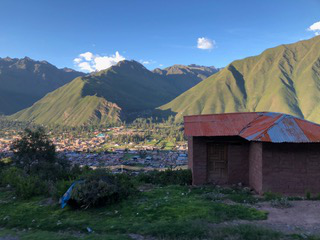
How many patients did you see per day, on average?
DONNA: We saw 509 patients in five days, so a little over 100 patients a day.
What were some of the most common conditions you treated?
DONNA: All the urological complaints were triaged to me, and then I would see any of the overflow. I saw various infections and a lot of orthopedic-related issues, since the labor of farming leads to back/joint pain. Many patients came in for a wellness check. And I was surprised by how many men came in specifically to get their prostate checked.
In terms of ages, we saw an age range from 2 months to 93 years. We diagnosed two cases of TB that we referred out, and I found a few cancers that were referred out as well. Referrals meant that Dr. Morales would help with logistics to get the patients to the local hospital six hours away.
Being the only English speaking health care provider, I did a lot of teaching with the 15 students, which I really enjoyed. You may see some of these students at the Dedham office over the next two years.
Do any cases linger with you?
DONNA: One patient that sticks with me is a 50-year-old male who broke his ankle falling out of a tree while picking avocados. For a month, he had been walking on a broken ankle, applying a homemade poultice from tea to the ankle for pain and then wrapping it in toilet paper.
During the physical exam, I could tell the ankle was broken. However, the patient couldn't stop working and walking on it, nor could he afford to go to Cusco to have it properly treated. I was able to give him some pain medication. His ankle will probably heal with obvious deformity and limited use, but he'll carry on leading his life the best he can. He accepted this as normal and was grateful for the limited care I could give him.
That's what surprised me the most about Peru: how patients persevere with very limited healthcare. It was frustrating not being able to do more for some of the patients.
What's one of your most vivid memories?
DONNA: On the first day, entering the stadium where our clinic was located and seeing all the patients sitting quietly in the stands waiting to be seen.
Do you plan on taking any future trips?
DONNA: Yes, I definitely want to participate in another mission. My husband and I are hoping to take our son, James, on one of FNE's building missions. James is currently a high school freshman.
Now, how about some pictures!
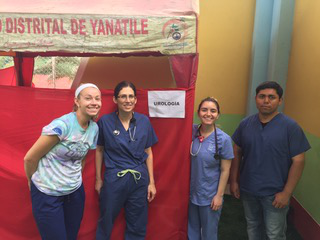
In the picture above, Donna stands in front of her medical tent for the day. She is the second from the left in the dark blue scrubs. With her are two medical students and a translator.
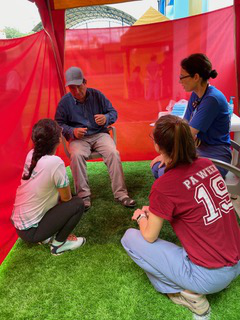
In the picture above, Donna (in blue scrubs on the right) evaluates a patient inside the medical tent.
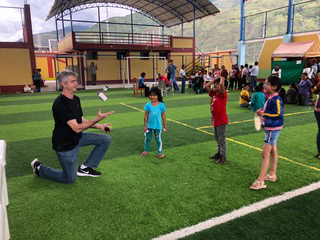
In this picture, Donna's husband Jason juggles for some of the local children.
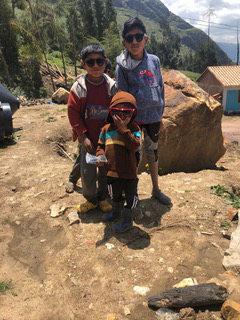
And, finally, in this picture, local children wear the sunglasses that Donna and her team provided.
